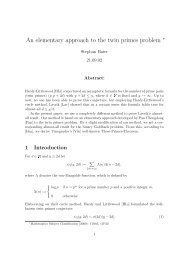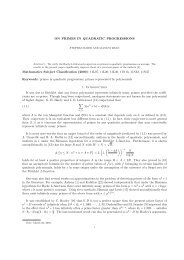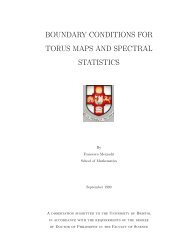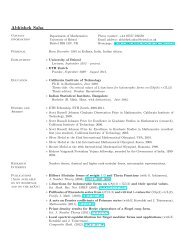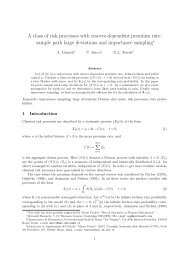Almost-all results on the p^\lambda problem
Almost-all results on the p^\lambda problem
Almost-all results on the p^\lambda problem
Create successful ePaper yourself
Turn your PDF publications into a flip-book with our unique Google optimized e-Paper software.
<str<strong>on</strong>g>Almost</str<strong>on</strong>g>-<str<strong>on</strong>g>all</str<strong>on</strong>g> <str<strong>on</strong>g>results</str<strong>on</strong>g> <strong>on</strong> <strong>the</strong> p λ <strong>problem</strong> II ∗<br />
Stephan Baier<br />
01.11.04<br />
Abstract:<br />
Suppose that 1/2 ≤ λ < 1. Balog and Harman proved that for any real θ <strong>the</strong>re exist<br />
infinitely many primes p satisfying �<br />
pλ − θ �<br />
< p−(1−λ)/2+ε (with an asymptotic result).<br />
In <strong>the</strong> present paper we establish that for almost <str<strong>on</strong>g>all</str<strong>on</strong>g> θ in <strong>the</strong> interval 0 ≤ θ < 1 <strong>the</strong>re<br />
exist infinitely many primes p such that �<br />
pλ − θ �<br />
< p− min{(2−λ)/6,(14−9λ)/32}+ε . Thus we<br />
obtain a better result for almost-<str<strong>on</strong>g>all</str<strong>on</strong>g> θ than for a single θ if λ > 1/2.<br />
1 Introducti<strong>on</strong><br />
In [1], [2], [3], [4], [5], [6], [8], [9], Balog, Harman and <strong>the</strong> author of <strong>the</strong> present paper<br />
studied <strong>the</strong> distributi<strong>on</strong> of fracti<strong>on</strong>al parts of p λ , p running over <strong>the</strong> prime numbers and<br />
λ being a given real number lying in <strong>the</strong> interval 0 < λ < 1. In <strong>the</strong> sequel, we refer to<br />
this questi<strong>on</strong> as <strong>the</strong> p λ <strong>problem</strong>. Balog’s and Harman’s result for <strong>the</strong> range 1/2 ≤ λ < 1<br />
(see [4], [6, Theorem 2] and [8]) can be formulated as follows.<br />
Theorem 1: Suppose that B > 0, λ ∈ [1/2, 1) and a real θ are given. Then for any<br />
fixed τ in <strong>the</strong> range 0 ≤ τ < (1 − λ)/2 we have<br />
as N → ∞.<br />
�<br />
n ≤ N,<br />
� n λ − θ � < n −τ<br />
Λ(n) =<br />
N 1−τ<br />
1 − τ<br />
+ O<br />
� N 1−τ<br />
(log N) B<br />
Here, as in <strong>the</strong> following, Λ(n) denotes <strong>the</strong> v<strong>on</strong> Mangoldt functi<strong>on</strong>.<br />
It is an interesting questi<strong>on</strong> whe<strong>the</strong>r sharper <str<strong>on</strong>g>results</str<strong>on</strong>g> than Theorem 1 hold true for<br />
almost <str<strong>on</strong>g>all</str<strong>on</strong>g> θ. In [2] <strong>the</strong> author already established almost-<str<strong>on</strong>g>all</str<strong>on</strong>g> <str<strong>on</strong>g>results</str<strong>on</strong>g> <strong>on</strong> <strong>the</strong> p λ <strong>problem</strong><br />
for 0 < λ < 1/2. He obtained <strong>the</strong> following result by using density <strong>the</strong>orems for <strong>the</strong><br />
n<strong>on</strong>-trivial zeta zeros.<br />
∗ Ma<strong>the</strong>matics Subject Classificati<strong>on</strong> (2000): 11N05, 11L20<br />
1<br />
�<br />
(1)
Theorem 2: Let B > 0 and λ ∈ (0, 1/2) be given. Define<br />
⎧<br />
⎪⎨ 5/12 − λ/6 if λ ≤ 1/8,<br />
H(λ) := � �<br />
⎪⎩ 1 + λ/2 �2<br />
/3 − λ if 1/8 < λ ≤ 1/2.<br />
Then <strong>the</strong> asymptotic formula (1) holds true for almost <str<strong>on</strong>g>all</str<strong>on</strong>g> real θ with respect to <strong>the</strong><br />
Lebesgue measure if τ is any fixed real number lying in <strong>the</strong> range 0 ≤ τ < H(λ).<br />
In <strong>the</strong> present paper we use a completely different approach to prove <strong>the</strong> following<br />
almost-<str<strong>on</strong>g>all</str<strong>on</strong>g> result for <strong>the</strong> range 1/2 ≤ λ < 1.<br />
Theorem 3: Let B > 0 and λ ∈ [1/2, 1) be given. Define<br />
H(λ) := min{(2 − λ)/6, (14 − 9λ)/32}.<br />
Then <strong>the</strong> asymptotic formula (1) holds true for almost <str<strong>on</strong>g>all</str<strong>on</strong>g> real θ with respect to <strong>the</strong><br />
Lebesgue measure if τ is any fixed real number lying in <strong>the</strong> range 0 ≤ τ < H(λ).<br />
We note that <strong>the</strong> functi<strong>on</strong> H(λ) defined in Theorems 2 and 3 is c<strong>on</strong>tinuous <strong>on</strong> <strong>the</strong><br />
interval (0, 1) and that for λ0 = 1/2 we have H(λ0) = 1/4 = (1 − λ0)/2. For λ0 = 1/2<br />
Theorem 3 <strong>the</strong>refore does’nt provide any improvement bey<strong>on</strong>d <strong>the</strong> result of Theorem 1.<br />
However, for any λ ∈ (1/2, 1) <strong>the</strong> τ-range in Theorem 3 is wider than that in Theorem<br />
1.<br />
In [3] we improved <strong>the</strong> result of Theorem 3 for single θ’s in <strong>the</strong> range 59/85 =<br />
0.694... < λ < 1. There we proved that in this range <strong>the</strong> exp<strong>on</strong>ent −(1 − λ)/2 + ε in<br />
Theorem 1 may be replaced by −G(λ) + ε, where<br />
G(λ) := min{max{(35 − 22λ)/129, 1/7}, 5/18 − λ/6}.<br />
Even this result is exceeded by that of Theorem 3 for almost-<str<strong>on</strong>g>all</str<strong>on</strong>g> θ since in <strong>the</strong> range<br />
59/85 < λ < 1 we have H(λ) > G(λ).<br />
In a similar manner like [2, Theorem 2] was derived from [2, Propositi<strong>on</strong>], we sh<str<strong>on</strong>g>all</str<strong>on</strong>g><br />
later derive <strong>the</strong> asserti<strong>on</strong> of Theorem 3 from<br />
Theorem 4: Let <strong>the</strong> c<strong>on</strong>diti<strong>on</strong>s of Theorem 3 be kept, and suppose that C > 0.<br />
Then we have<br />
as N → ∞.<br />
�1<br />
0<br />
�<br />
�<br />
�<br />
�<br />
�<br />
�<br />
�<br />
�<br />
�<br />
�<br />
�<br />
n ≤ N,<br />
� n λ − θ � < n −τ<br />
Λ(n) −<br />
N 1−τ<br />
1 − τ<br />
�<br />
�2<br />
�<br />
�<br />
�<br />
�<br />
�<br />
�<br />
�<br />
�<br />
dθ ≪ N 2(1−τ )<br />
(log N) C<br />
Acknowledgements. This research has been supported by a Marie Curie Fellowship<br />
of <strong>the</strong> European Community programme “Improving <strong>the</strong> Human Research Potential<br />
and <strong>the</strong> Socio-Ec<strong>on</strong>omic Knowledge Base” under c<strong>on</strong>tract number HPMF-CT-2002-<br />
02157.<br />
2<br />
(2)
2 Reducti<strong>on</strong> to exp<strong>on</strong>ential sums<br />
We sh<str<strong>on</strong>g>all</str<strong>on</strong>g> employ a similar method like in [3], where we linked <strong>the</strong> p λ <strong>problem</strong> with<br />
Piatetski-Shapiro primes, that is, primes of <strong>the</strong> form [n c ] with fixed c > 1 and n ∈ �.<br />
A standard procedure for attacking <strong>problem</strong>s related to Piatetski-Shapiro primes is as<br />
follows (see [11] for instance): Firstly, <strong>on</strong>e reduces <strong>the</strong> sum of Λ(n) in questi<strong>on</strong> (in our<br />
paper, this is <strong>the</strong> sum <strong>on</strong> <strong>the</strong> left-hand side of (1)) to exp<strong>on</strong>ential sums of <strong>the</strong> form<br />
�<br />
n∼N<br />
Λ(n)e �<br />
hn λ�<br />
.<br />
Sec<strong>on</strong>dly, <strong>on</strong>e breaks up <strong>the</strong>se exp<strong>on</strong>ential sums into certain bilinear exp<strong>on</strong>ential sums<br />
(so-c<str<strong>on</strong>g>all</str<strong>on</strong>g>ed type I and type II sums) by using Vaughan-type identities. Fin<str<strong>on</strong>g>all</str<strong>on</strong>g>y, <strong>on</strong>e estimates<br />
<strong>the</strong>se bilinear exp<strong>on</strong>ential sums in a n<strong>on</strong>-trivial way. Here we also follow this<br />
approach. However, since <strong>the</strong> first two steps were completely carried out in several papers<br />
(see [11] for example), we omit some details in <strong>the</strong>se steps.<br />
Throughout <strong>the</strong> following, we suppose that λ, τ and t are given real numbers satisfying<br />
1/2 ≤ λ < 1 and 0 ≤ τ < t < 1, and we put<br />
H := N t .<br />
The parameter t will later be choosen suitably subject to λ and τ. Fur<strong>the</strong>rmore, we<br />
suppose that η is a (sm<str<strong>on</strong>g>all</str<strong>on</strong>g>) positive real number. By <strong>the</strong> notati<strong>on</strong> k ∼ K we mean k to<br />
lie in some interval K1 ≤ k ≤ K2 with K/2 ≤ K1 ≤ K2 ≤ 2K.<br />
Using <strong>the</strong> Fourier series expansi<strong>on</strong> of {x}, we obtain<br />
Lemma 1: Suppose that (ah) is a sequence of complex numbers. Assume that we<br />
uniformly have, as N → ∞,<br />
�<br />
ah<br />
�<br />
1≤h≤H N
�<br />
1 − e � ��<br />
−τ<br />
hx ≪ hx −τ−1 ,<br />
∂<br />
∂x<br />
and taking into c<strong>on</strong>siderati<strong>on</strong> that <strong>the</strong> O-c<strong>on</strong>stant in (1) depends <strong>on</strong>ly <strong>on</strong> <strong>the</strong> O-c<strong>on</strong>stant<br />
in (3).<br />
Lemma 2: We have (2) if<br />
for a suitable η > 0.<br />
sup<br />
N
We sh<str<strong>on</strong>g>all</str<strong>on</strong>g> prove <strong>the</strong> following lemma by adapting a method of Heath-Brown (see [11,<br />
page 257]).<br />
Lemma 4: Let Qh be any positive integer. Then<br />
|Lh| 2 �<br />
≪ QhX �<br />
hX λ Y λ Q −1<br />
�1/2 �<br />
h Q −1<br />
h Y 2 + Y �<br />
Then<br />
Proof: For q ∈ � we define <strong>the</strong> interval Iq by<br />
Iq := �<br />
Y λ (q − 1)/Qh, Y λ �<br />
q/Qh .<br />
|Lh| ≪ �<br />
q≤2Qh<br />
�<br />
m∼X<br />
| �<br />
n ∼ Y,<br />
n λ ∈ Iq,<br />
mn ∼ N<br />
�<br />
2−λ<br />
+ QhX h −1 Y 2−λ + Y X λ��<br />
(log N).<br />
bne �<br />
hm λ n λ�<br />
|.<br />
From that, using <strong>the</strong> Cauchy-Schwarz inequality, we obtain<br />
|Lh| 2 ≪ QhX � �<br />
| �<br />
bne �<br />
hm λ n λ�<br />
| 2<br />
q≤2Qh<br />
≪ QhX �<br />
q≤2Qh<br />
≪ QhX �<br />
m∼X<br />
�<br />
n ∼ Y,<br />
n λ ∈ Iq<br />
n, r ∼ Y,<br />
|t| ≤ 2Y λ /Qh<br />
n ∼ Y,<br />
nλ ∈ Iq,<br />
mn ∼ N<br />
�<br />
r ∼ Y,<br />
r λ ∈ Iq<br />
| �<br />
m ∼ X,<br />
mn ∼ N,<br />
mr ∼ N<br />
| �<br />
m ∼ X,<br />
mn ∼ N,<br />
mr ∼ N<br />
e �<br />
h(n λ − r λ )m λ�<br />
|<br />
e �<br />
htm λ�<br />
|, (5)<br />
where we put t := n λ − r λ . Applying [11, Lemma 1] to <strong>the</strong> inner sum in <strong>the</strong> last line of<br />
(5), we get<br />
�<br />
m ∼ X,<br />
mn ∼ N,<br />
mr ∼ N<br />
e �<br />
htm λ�<br />
�<br />
≪ min X, (ht) −1 X 1−λ + �<br />
htX λ�1/2 �<br />
≤ �<br />
htX λ� 1/2<br />
+ X min �<br />
1, (ht) −1 X −λ�<br />
. (6)<br />
Combining (5) and (6), and using partial summati<strong>on</strong>, we obtain<br />
where<br />
|Lh| 2 ≪ QhX �<br />
hX λ Y λ Q −1<br />
�1/2 h S �<br />
2Y λ Q −1<br />
�<br />
h +<br />
QhX 2 S �<br />
h −1 X −λ�<br />
+ h −1 QhX 2−λ (log N) max<br />
∆≥h−1X −λ S(∆)∆−1 , (7)<br />
5
Obviously, we have<br />
S(∆) := �<br />
n, r ∼ Y,<br />
|t| ≤ ∆<br />
Combining (7) and (8), we obtain <strong>the</strong> desired estimate. ✷<br />
To optimize <strong>the</strong> estimate in Lemma 4, we choose<br />
1.<br />
S(∆) ≪ ∆Y 2−λ + Y. (8)<br />
Qh := 1 + �<br />
h 1/3 X (λ−2)/3 Y (λ+2)/3�<br />
.<br />
Then, by a short calculati<strong>on</strong> using J ≤ H = N t and XY = N, we obtain<br />
when<br />
Lemma 5: We have<br />
�<br />
h≤H<br />
This implies<br />
|Lh| 2 ≪ �<br />
N 1+λ/2+3t/2 + N 2−λ + N 2+t Y −1 + N 4/3+λ/3+4t/3 Y 1/3 +<br />
N 2/3+2λ/3+5t/3 Y 2/3 + N 4/3−2λ/3+t/3 Y 4/3�<br />
(log N).<br />
Lemma 6: For every sufficiently sm<str<strong>on</strong>g>all</str<strong>on</strong>g> fixed η > 0 we have<br />
provided <strong>the</strong> c<strong>on</strong>diti<strong>on</strong>s<br />
are satisfied.<br />
4 Treatment of Kh<br />
�<br />
|Lh|<br />
h≤H<br />
2 ≪ N 2−2η<br />
N t+100η ≤ Y ≤ N 2−λ−4t−100η ,<br />
t < (2 − λ)/3, t > 2(1 − λ)/5 (9)<br />
Heath-Brown established <strong>the</strong> following two estimates for Kh (see [11, pages 261-262]).<br />
Lemma 7: (i) We have<br />
6
�<br />
2<br />
Kh ≪ (log N) N 1−λ h −1 + Xh 1/2 N λ/2�<br />
.<br />
(ii) Let (p, q) be any exp<strong>on</strong>ent pair for which 0 < p ≤ 1/2 ≤ q ≤ 1. Let P be any<br />
positive integer. Then<br />
|Kh| 2 ≪ (log N) 8 (X + NP −1 ) �<br />
N + N (p+1/2)λ Y q−2p−1/2 H p+1/2 P p+3/2 +<br />
N 1−λ/2 Y 1/2 h −1/2 P 1/2 + Y P �<br />
.<br />
Taking <strong>the</strong> exp<strong>on</strong>ent pair (p, q) = (2/7, 4/7), and choosing<br />
P := �<br />
N (2−(1+2p)(λ+t))/(2p+3) Y (4p+1−2q)/(2p+3)�<br />
= �<br />
N (14−11(λ+t))/25 Y 7/25�<br />
,<br />
from Lemma 7, we obtain<br />
Lemma 8: (i) We have<br />
(ii) We have<br />
�<br />
h≤H<br />
�<br />
h≤H<br />
|Kh| 2 �<br />
4<br />
≪ (log N) N 2(1−λ) + X 2 N λ+2t�<br />
.<br />
|Kh| 2 �<br />
8<br />
≪ (log N) N (36+11λ+36t)/25 Y −7/25 + N (43−7λ+18t)/25 Y 9/25 + N 1+t Y +<br />
provided <strong>the</strong> c<strong>on</strong>diti<strong>on</strong><br />
is satisfied.<br />
when<br />
N 2+t Y −1 + N (57−18λ+7t)/25 Y −9/25�<br />
,<br />
From <strong>the</strong> preceding lemma, we derive<br />
t < 14/11 − λ (10)<br />
Lemma 9: (i) For every sufficiently sm<str<strong>on</strong>g>all</str<strong>on</strong>g> fixed η > 0 we have<br />
�<br />
|Kh|<br />
h≤H<br />
2 ≪ N 2−2η<br />
N (λ+2t)/2+100η ≤ Y.<br />
(ii) For every sufficiently sm<str<strong>on</strong>g>all</str<strong>on</strong>g> fixed η > 0 we have (11) when<br />
N max{(11λ+36t)/7−2,t}+100η ≤ Y ≤ N min{1−t,7(1+λ)/9−2t}−100η ,<br />
7<br />
(11)
provided <strong>the</strong> c<strong>on</strong>diti<strong>on</strong> (10) is satisfied.<br />
We are now in a positi<strong>on</strong> to prove<br />
Lemma 10: For every sufficiently sm<str<strong>on</strong>g>all</str<strong>on</strong>g> fixed η > 0 we have (11) when<br />
N t+100η ≤ Y,<br />
provided <strong>the</strong> c<strong>on</strong>diti<strong>on</strong>s in (9) and (10) as well as <strong>the</strong> c<strong>on</strong>diti<strong>on</strong>s<br />
are satisfied.<br />
t < (2 − λ)/5, t < (14 + 5λ)/54, t < (14 − 9λ)/32 (12)<br />
Proof: We first note that <strong>the</strong> sum �<br />
same manner as �<br />
h≤H<br />
h≤H<br />
|Kh| 2 can alternatively be estimated in <strong>the</strong><br />
|Lh| 2 was estimated in Lemma 6. Thus, we also have (11) when<br />
N t+100η ≤ Y ≤ N 2−λ−4t−100η ,<br />
provided <strong>the</strong> c<strong>on</strong>diti<strong>on</strong>s in (9) are satisfied. By this observati<strong>on</strong> and Lemma 9, for proving<br />
Lemma 10 it suffices to show that<br />
and<br />
(λ + 2t)/2 < min{1 − t, 7(1 + λ)/9 − 2t} (13)<br />
max{(11λ + 36t)/7 − 2, t} < 2 − λ − 4t. (14)<br />
Indeed, (13) follows from <strong>the</strong> first and <strong>the</strong> sec<strong>on</strong>d c<strong>on</strong>diti<strong>on</strong> in (12), and (14) follows<br />
from <strong>the</strong> first and <strong>the</strong> third c<strong>on</strong>diti<strong>on</strong> in (12). This completes <strong>the</strong> proof. ✷<br />
5 Proof of Theorem 4<br />
We suppose that 1/2 ≤ λ < 1 and<br />
We choose t in such a manner that<br />
and we take<br />
0 ≤ τ < min{(2 − λ)/6, (14 − 9λ)/32}.<br />
max{τ, 2(1 − λ)/5} < t < min{(2 − λ)/6, (14 − 9λ)/32},<br />
u := N t+100η ,<br />
v := N 2−λ−4t−100η ,<br />
z := N t+100η .<br />
8
Then <strong>the</strong> c<strong>on</strong>diti<strong>on</strong>s in (9), (10), (12) to λ and t are satisfied. Moreover, since t <<br />
(2 − λ)/6, <strong>the</strong> c<strong>on</strong>diti<strong>on</strong>s in Lemma 3 to u, v, z are satsified if η is sufficiently sm<str<strong>on</strong>g>all</str<strong>on</strong>g> and<br />
N is sufficiently large.<br />
Now, putting Lemmas 2, 3, 6 and 10 toge<strong>the</strong>r, we obtain <strong>the</strong> result of Theorem 4. ✷<br />
6 Proof of Theorem 3<br />
Fin<str<strong>on</strong>g>all</str<strong>on</strong>g>y, we derive Theorem 3 from Theorem 4 by using <strong>the</strong> following lemma in metric<br />
number <strong>the</strong>ory which is essenti<str<strong>on</strong>g>all</str<strong>on</strong>g>y due to W.M.Schmidt.<br />
Lemma 11: (Lemma 1.5 in [10]) Let X be a measure space with measure µ such<br />
that 0 < µ(X) < ∞. Let fk(x) (k = 1, 2, ...) be a sequence of n<strong>on</strong>-negative µ-measurable<br />
functi<strong>on</strong>s, and let fk, ϕk be sequences of real numbers such that<br />
Write<br />
0 ≤ fk ≤ ϕk (k = 1, 2, ...). (15)<br />
Φ(M) := �<br />
and suppose that Φ(M) → ∞ as M → ∞. Suppose that for arbitrary integers m, n<br />
(1 ≤ m < n) we have<br />
�<br />
X<br />
k≤M<br />
ϕk,<br />
�<br />
�<br />
�<br />
� �<br />
�2<br />
�<br />
�<br />
�<br />
� (fk(x) − fk) �<br />
� dµ ≤ D0 ϕk<br />
�m≤k
k<br />
(log rk) B+1 ≪ rk − rk−1 ≪<br />
rk<br />
(log rk) B+1<br />
for <str<strong>on</strong>g>all</str<strong>on</strong>g> k ≥ 1, where B is <strong>the</strong> c<strong>on</strong>stant in Theorem 3. We note that<br />
k ≪ (log rk) B+2<br />
by this c<strong>on</strong>structi<strong>on</strong>. We put X := [0, 1], define µ to be <strong>the</strong> Lebesgue measure, and<br />
define<br />
fk(θ) :=<br />
fk := r1−τ k<br />
�<br />
rk−1 < n ≤ rk,<br />
� n λ − θ � < n −τ<br />
− r1−τ k−1<br />
1 − τ<br />
,<br />
Λ(n),<br />
r<br />
ϕk := D1 ·<br />
2(1−τ)<br />
k<br />
,<br />
(log rk) 3B+6<br />
where D1 is choosen in such a manner that (15) holds for <str<strong>on</strong>g>all</str<strong>on</strong>g> positive integers k. We<br />
note that<br />
fk ≪<br />
r1−τ<br />
k<br />
(log rk) B+1<br />
by (18) and Taylor’s formula.<br />
Then <strong>the</strong> c<strong>on</strong>diti<strong>on</strong> “Φ(M) → ∞ as M → ∞” in Lemma 11 is satisfied since we<br />
have rk → ∞ as k → ∞. By Theorem 4, also <strong>the</strong> inequality (16) is satisfied for a<br />
suitable c<strong>on</strong>stant D0 (to see this, we apply <strong>the</strong> Cauchy-Schwarz inequality). Hence,<br />
<strong>the</strong> asymptotic estimate (17) indeed holds for almost <str<strong>on</strong>g>all</str<strong>on</strong>g> x ∈ [0, 1] with respect to <strong>the</strong><br />
Lebesgue measure. Moreover, by (19) we have<br />
Φ(M) ≪<br />
r2(1−τ)<br />
M<br />
(log rM) 2B+4<br />
as M → ∞. Using (17), (20) and (21), we obtain, as M → ∞,<br />
�<br />
n ≤ rM ,<br />
� n λ − θ � < n −τ<br />
Λ(n) = r1−τ M<br />
1 − τ<br />
+ O �<br />
r 1−τ<br />
M (log rM) −(B+1)�<br />
for almost <str<strong>on</strong>g>all</str<strong>on</strong>g> θ ∈ [0, 1].<br />
Fin<str<strong>on</strong>g>all</str<strong>on</strong>g>y, we pick θ ∈ [0, 1] for which (22) holds, and we seek to show that <strong>the</strong>n even<br />
(1) holds for this θ. To do so, we proceed as follows: For a given N ≥ 2 let M be <strong>the</strong><br />
positive integer for which rM−1 < N ≤ rM. Then, by c<strong>on</strong>structi<strong>on</strong> of <strong>the</strong> sequence (rk),<br />
we have<br />
rM − N ≪<br />
rM<br />
≪<br />
(log rM) B+1<br />
10<br />
N<br />
.<br />
(log N) B+1<br />
(18)<br />
(19)<br />
(20)<br />
(21)<br />
(22)
Using this inequality, (22) and Taylor’s formula, we obtain <strong>the</strong> asymptotic estimate (1).<br />
This completes <strong>the</strong> proof of Theorem 3.<br />
References<br />
[1] S. Baier, On <strong>the</strong> p λ <strong>problem</strong>, Acta Arith. 113 (2004), 77-101.<br />
[2] S. Baier, <str<strong>on</strong>g>Almost</str<strong>on</strong>g>-<str<strong>on</strong>g>all</str<strong>on</strong>g> <str<strong>on</strong>g>results</str<strong>on</strong>g> <strong>on</strong> <strong>the</strong> p λ <strong>problem</strong>, to appear in Acta Math. Hungarica.<br />
[3] S. Baier, An extensi<strong>on</strong> of <strong>the</strong> Piatetski-Shapiro prime number <strong>the</strong>orem, preprint<br />
(2004).<br />
[4] A. Balog, On <strong>the</strong> fracti<strong>on</strong>al part of p θ , Arch. Math. (Basel) 40 (1983), 434-440.<br />
[5] A. Balog, On <strong>the</strong> distributi<strong>on</strong> of p θ mod 1, Acta Math. Hung. 45 (1985), 179-199.<br />
[6] A. Balog, G. Harman, On mean values of Dirichlet polynomials, Arch. Math.<br />
(Basel) 57 (1991), 581-587.<br />
[7] S.W. Graham, G. Kolesnik, Van der Corput ′ s Method of Exp<strong>on</strong>ential Sums, Cambridge<br />
University Press, 1991.<br />
[8] G. Harman, On <strong>the</strong> distributi<strong>on</strong> of √ p modulo <strong>on</strong>e, Ma<strong>the</strong>matika 30 (1983), 104-<br />
116.<br />
[9] G. Harman, Fracti<strong>on</strong>al and integral parts of p λ , Acta Arith. 58 (1991), 141-152.<br />
[10] G. Harman, Metric Number Theory, Oxford Science Publicati<strong>on</strong>s, Clarend<strong>on</strong> Press,<br />
Oxford (1998).<br />
[11] D.R. Heath-Brown, The Pjateckii-Shapiro Prime Number Theorem, J. Number<br />
Theory 16 (1983), 242-266.<br />
[12] R.C. Vaughan, On <strong>the</strong> Estimati<strong>on</strong> of Trig<strong>on</strong>ometrical Sums over Primes, and Related<br />
Questi<strong>on</strong>s, Report No. 9, Institut Mittag-Leffler, 1977.<br />
HARISH-CHANDRA RESEARCH INSTITUTE<br />
CHHATNAG ROAD<br />
JHUSI<br />
ALLAHABAD 211 019<br />
INDIA<br />
E-MAIL: SBAIER@MRI.ERNET.IN<br />
11





